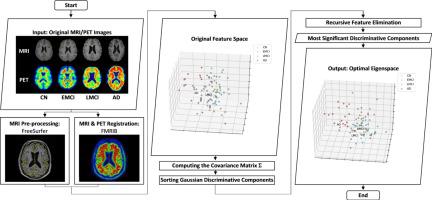Journal of Neuroscience Methods ( IF 2.7 ) Pub Date : 2020-07-11 , DOI: 10.1016/j.jneumeth.2020.108856 Chen Fang 1 , Chunfei Li 1 , Parisa Forouzannezhad 1 , Mercedes Cabrerizo 1 , Rosie E Curiel 2 , David Loewenstein 2 , Ranjan Duara 3 , Malek Adjouadi 4 ,

|
Background
Using multiple modalities of biomarkers, several machine leaning-based approaches have been proposed to characterize patterns of structural, functional and metabolic differences discernible from multimodal neuroimaging data for Alzheimer’s disease (AD). Current investigations report several studies using binary classification often augmented with local feature selection methods, while fewer other studies address the challenging problem of multiclass classification.
New method
To assess the merits of each of these research directions, this study introduces a supervised Gaussian discriminative component analysis (GDCA) algorithm, which can effectively delineate subtle changes of early mild cognitive impairment (EMCI) group in relation to the cognitively normal control (CN) group. Using 251 CN, 297 EMCI, 196 late MCI (LMCI), and 162 AD subjects from the Alzheimer’s Disease Neuroimaging Initiative (ADNI) and considering both structural and functional (metabolic) information from magnetic resonance imaging (MRI) and positron emission tomography (PET) modalities as input, the proposed method conducts a dimensionality reduction algorithm taking into consideration the interclass information to define an optimal eigenspace that maximizes the discriminability of selected eigenvectors.
Results
The proposed algorithm achieves an accuracy of 79.25 % for delineating EMCI from CN using 38.97 % of Gaussian discriminative components (i.e., dimensionality reduction). Moreover, for detecting the different stages of AD, a multiclass classification experiment attained an overall accuracy of 67.69 %, and more notably, discriminates MCI and AD groups from the CN group with an accuracy of 75.28 % using 48.90 % of the Gaussian discriminative components.
Comparison with existing method(s)
The classification results of the proposed GDCA method outperform the more recently published state-of-the-art methods in AD-related multiclass classification tasks, and seems to be the most stable and reliable in terms of relating the most relevant features to the optimal classification performance.
Conclusion
The proposed GDCA model with its high prospects for multiclass classification has a high potential for deployment as a computer aided clinical diagnosis system for AD.
中文翻译:

用于早期检测阿尔茨海默病的高斯判别分量分析:一种监督降维算法。
背景
使用多种生物标记物模态,已经提出了几种基于机器学习的方法来表征从阿尔茨海默病(AD)的多模态神经影像数据中可辨别的结构、功能和代谢差异的模式。目前的调查报告了几项使用二元分类的研究,这些分类通常通过局部特征选择方法进行增强,而其他研究很少解决多类分类的挑战性问题。
新方法
为了评估每个研究方向的优点,本研究引入了监督高斯判别成分分析(GDCA)算法,该算法可以有效地描绘早期轻度认知障碍(EMCI)组相对于认知正常对照(CN)的细微变化团体。使用来自阿尔茨海默病神经影像计划 (ADNI) 的 251 名 CN、297 名 EMCI、196 名晚期 MCI (LMCI) 和 162 名 AD 受试者,并考虑来自磁共振成像 (MRI) 和正电子发射断层扫描 (PET) 的结构和功能(代谢)信息)模态作为输入,所提出的方法考虑类间信息进行降维算法,以定义最大化所选特征向量的可辨别性的最佳特征空间。
结果
该算法使用 38.97% 的高斯判别分量(即降维)从 CN 描绘 EMCI,准确率达到 79.25%。此外,为了检测 AD 的不同阶段,多类分类实验的总体准确率达到 67.69%,更值得注意的是,使用 48.90% 的高斯判别分量将 MCI 和 AD 组与 CN 组区分开来,准确率达到 75.28%。
与现有方法的比较
所提出的 GDCA 方法的分类结果优于最近发布的 AD 相关多类分类任务中最先进的方法,并且在将最相关的特征与最佳分类相关联方面似乎是最稳定和可靠的表现。
结论
所提出的 GDCA 模型具有多类分类的良好前景,具有作为 AD 计算机辅助临床诊断系统部署的巨大潜力。











































 京公网安备 11010802027423号
京公网安备 11010802027423号